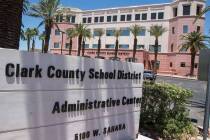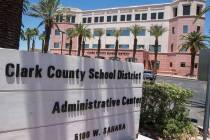Southwest valley parents oppose school rezoning
The angst was all over the faces of 100 parents.
They begged the Clark County School District not to shift attendance boundaries and push their children into different schools, even if that relieves crowding at southwest valley campuses such as Forbuss Elementary School.
The school, near Blue Diamond and Fort Apache roads, has 1,200 students, 400 more than it was built to have. But most parents don't want their children to leave.
"The school is a way of life in our community," one mother told the district's Attendance Zone Advisory Commission.
Parents had their last chances Tuesday and Wednesday night to sway the commission. It will reconvene Tuesday to recommend how the district should redraw zones and alleviate crowding at southwest elementary schools. The Clark County School Board will vote on the new zones March 6. The changes are expected to affect 15 to 20 schools in 2013-14.
Grandfather Charles Hauntz put emotion aside Tuesday night as he stood in front of the microphone.
He pointed out what he sees as flaws in the district's three rezoning proposals under consideration.
"We're going to shuffle around 2,500 kids and just move them from one crowded school to another," he said.
Districtwide, enrollment is 9 percent over capacity for Clark County's 217 elementary schools.
However, at nearly 40 elementary schools, staff members are teaching a quarter more students than their buildings were built for, relying on portable classrooms and even portable bathrooms to do so.
Crowding is occurring at elementary schools throughout the district but is concentrated in the southwest. The proposals would affect 15 to 20 schools in that area. Each plan would move about 2,500 to 2,700 students to relieve pressure at eight schools: Batterman, Bendorf, Forbuss, Reedom, Ries, Steele, Tanaka and Wright.
Those schools exceed their limits in rates from 111 percent to 151 percent of capacity.
The problem is that two proposals wouldn't solve the problem so much as "move it," said Rick Baldwin, the district's director of demographics and zoning. Using either one would leave eight schools at 110 percent or more of their capacities.
For example, Proposal 1 would relieve pressure at schools such a Forbuss, taking away about 300 students, leaving the school 14 percent over capacity next year instead of 51 percent.
The previously under-enrolled Rogers Elementary School would be given an estimated 338 students, pushing it 38 percent over capacity.
And some of the already packed schools would have to jam in more students. Tanaka already has 200 more students than it was built to have, meaning it's a quarter over capacity. Proposal 1 would add 167 more children to Tanaka, and Proposal 2 would add 119 children.
All these estimated changes use student head counts from the beginning of the school year, Baldwin said. By next school year, the number of students in the southwest valley is expected to increase by more than 1,000. Area schools probably will be even more crowded than they are now.
Baldwin said Proposal 3 is preferred. Most parent testimony confirmed that at this week's public hearings.
Seven of the eight most severely crowded schools would lose students under Proposal 3, but they still would be at 118 percent to 137 percent of their capacities.
Several schools with room would be pushed past full. Rogers would exceed its capacity by 200 students if Proposal 3 is adopted.
That's why Hauntz told district officials to go back to the drawing board.
Contact reporter Trevon Milliard at tmilliard@review journal.com or 702-383-0279.

















